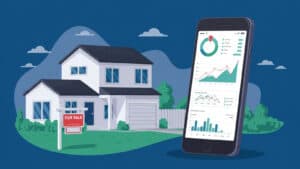
How to Get the Most ROI From Property Investment Software
Margins are tightening for businesses all throughout the real estate industry, and property investors are also squeezed by rising property, renovation, and service costs. While the gross profit for flips has incrementally increased by $2,900 since 2017, that represents an ROI that’s fallen by more than half of its 2017 ROI of 51.4%. These tightening margins don’t mean that real estate investment is no longer profitable—far from it.
It does mean that investors should carefully consider the properties they invest in and all the tools and services they use to make business happen. While property investment software is becoming increasingly universal for everyone, from hobbyist investors to full-time multi-family property investors, the software also needs careful evaluation.
Simply purchasing expensive tools and subscribing to recurring services is a poor financial strategy for any business. Those costs will add up and eat into the profit margins for each property. Even worse, without a dedicated workflow where every tool brings value, you may be paying for software you don’t use and don’t need.
Instead, take a measured approach to the adoption of property investment software. These tools bring clear value and opportunities for business growth, and by using a step-by-step strategy for growing and maturing your property investment tech stack, you can efficiently do business with a better ROI.
Benefits of Prioritizing Property Investment Software ROI
Incorporating property investment software into running your business is one of the most beneficial decisions you can make to improve and see a greater ROI. However, it’s not enough to see revenue growth from using property investment software. Something as simple as automating your invoicing process for collecting rent can increase your ROI, and adding your business bank app onto your phone gives you more visibility into your account levels.
Expert property investors take this one step further by developing a more nuanced approach. They focus specifically on maximizing the ROI of the software itself. At a basic level, this involves price comparison, looking for specific features, and measuring how much value you get.
The benefits of maximizing your software ROI include:
- Far more control over your expenses: You can consolidate the costs of different tools by selecting comprehensive platforms, switching to different tools based on the price, and gathering analytics about the cost and value of each platform.
- Constant awareness of new developments in the real estate investment tech market: When you’re strategically researching different tools over time, you can be on the leading edge of adopting new tools that outperform what your competitors are using. For example, switching to smart pricing tools that use AI can make your listing prices more accurate, and it only takes a fraction of the time of manual research. If you stopped developing your tech stack once you found an online market research tool, you’d never see the new opportunity.
- Trimming away inefficient costs: Depending on the size of your team and business, software tools may have a negligible cost, or they might be costing you thousands of dollars a month. All of these costs add up throughout the years. When you focus on the ROI of your tech stack, you can cut out the dead weight of apps you don’t use, switch out subpar platforms for better options, and put high-performance tools to better use.
- Business scalability: Technology allows you to grow your business without ballooning your costs. By auditing your tech stack now and perenially in the future, you can continue to make it leaner and then easier to add more licenses, premium services, and credits once your business demands it.
Related: MLS Access for Investors: What You Need to Know
These benefits can make your real estate investment business stronger, and simply using software without a critical assessment isn’t enough.
Step-by-Step Process for Getting the Most Out of Your Property Investment Software
When you want to make your tech stack more efficient and ensure you’re getting as much value as possible, adopt a methodical approach to evaluating platforms and their impact. This four-step strategy can be used whether you already have software that you want a better handle on or you’re just starting to use software and want a strong foundation.
Step 1. Identify the Biggest Costs in Your Current Processes
Start by closely assessing your current operations. List the biggest costs and inefficiencies in your business, including:
- Money spent on consultants, property managers, and real estate agents, as well as assistants or VAs
- Time spent on researching, buying, and managing properties—Many new investors fail to account for the time they spend on the business or undervalue their own hours. This is a mistake, as it can cause burnout and make it very challenging to scale your business. Instead, measure your time and the value of those hours.
- Manual tasks and processes that you believe can be partially or completely handled by technology
- Expenses like technology costs, recurring subscriptions, and annual fees
During this first step, focus solely on identifying costs, busy work, and hard tasks that are hurting your profitability. By listing these problem areas, you can address them one by one. Highlight the costliest inefficiencies or biggest problems. It’s wise to address these first to see the biggest marginal benefits.
Alternatively, highlight the problems that have the easiest solutions—for example, software you no longer use, expensive software that you want to find alternatives for, and so on. Then, you can quickly resolve these issues before tackling more complex challenges.
Step 2. Shop Around for Platforms and Online Tools That Can Address Those Problems
The next step is researching what property investment software is on the market. You can use a combination of general professional tools (such as Zelle, Mint for tracking expenses, DocuSign, and so on) and real estate-specific platforms and tools that address unique needs. The objective of this step is to look for software that directly solves an existing problem. Consider it a bonus if it provides additional benefits—such as a flat-fee listing service and property marketing software—but primarily focus on addressing the problems you’ve listed.
Step 3. Test Out the Tools and See How They Improve Your Processes
Then, implement your new tech stack. Purchase online services, subscribe to software solutions, and start using them for either ongoing or new property projects. As you start incorporating them into your workflows, set time aside to reflect on the value they bring. Some things to weigh as you experiment with new tools are:
- Are you spending less time on certain tasks?
- How is the software helping you either save money or earn more revenue?
- What are the other benefits you’re experiencing?
- What are the disadvantages or new challenges you’ve encountered?
During the initial adoption, it takes time to learn new software, and changing your professional workflow can be annoying. But after that transition, see what advantages the software is bringing to your processes and your balance sheet.
Step 4. Refine Your Approach With New Tools Over Time
By the end of the third step, you’ll have a well-functioning, beneficial tech stack. You’re not yet getting the most ROI possible from property investment software. To do that, repeat the steps again. Identify new challenges, inefficiencies, and costs you no longer want to pay or that are holding your business back. Then, you can research software on the market to find new tools that address the new problems or solve the old ones better.
Related: Smart Tools for Success: Top Apps for Real Estate Investors
Making iterative changes creates a good balance between efficiency and disruption. By just making moderate changes over time, you may lose some money compared to switching all at once. However, you retain better control over your processes and workflow. Similarly, keeping your processes the same is convenient but extremely limiting.
Helpful Tactics for Getting the Biggest ROI Out of Your Property Investment Software
Navigating the marketplace of available software can be overwhelming, especially when you’re optimizing for cost and performance. Keep these three best practices in mind to make every step easier:
- Avoid Subscriptions With Extra Services You Don’t Need: Instead, look for flat-fee and a la carte options so you only pay for what you need.
- Look for Tools Designed for Your Use Cases: While you can make do with some universal apps, niche real estate investor software is built for specific use cases you’re most likely to encounter. They’ll also have features (either now or as they continue to develop) that generalized tools won’t offer.
- Prioritize Platforms That Offer Multiple Services in One App: This simplifies your tech stack, makes it easier to track progress, and can reduce task switching.
- Measure Your Time and Mindset, Not Just Dollar Costs: Small business owners often undervalue their own expertise or don’t track their hourly work. Track the time you spend, assign yourself a fair hourly wage for easier tracking, and consider if you enjoy using one app over another. These factors shape how much you enjoy real estate investing over time.
See How Quickly You Get a Positive ROI With Property Investment Software
You may already know some of the major challenges your business has. Common problems include hiring an agent for MLS access, manually coordinating showings and open houses, and uncertainty regarding the rental rates or list prices you post for your properties. At ListingSpark, we offer real estate investment software that addresses those problems and countless others, all in one platform. Reach out today to see how our software can bring you a healthy return on investment for your next property transaction.
Related Posts
How to Price Your Home: Key Factors That Determine Market Value
Strategic home pricing reduces market time and attracts more qualified buyers through competitive positioning. Set your price using recent sales data, consider seasonal timing, and stay flexible based on market feedback to maximize your sale…
Selling a House Without a Realtor: Hidden Costs & Risks
When homeowners consider the risks of selling a house without a realtor, they often focus solely on potential commission savings. However, FSBO homes sold for a median of $380,000 in 2024, compared to $435,000 for…
Do You Need a Realtor to Sell a House?
The latest data from the National Association of Realtors shows that 90% of home sellers use agents, but this raises an important question: Do you need a realtor to sell a house? While the majority…




